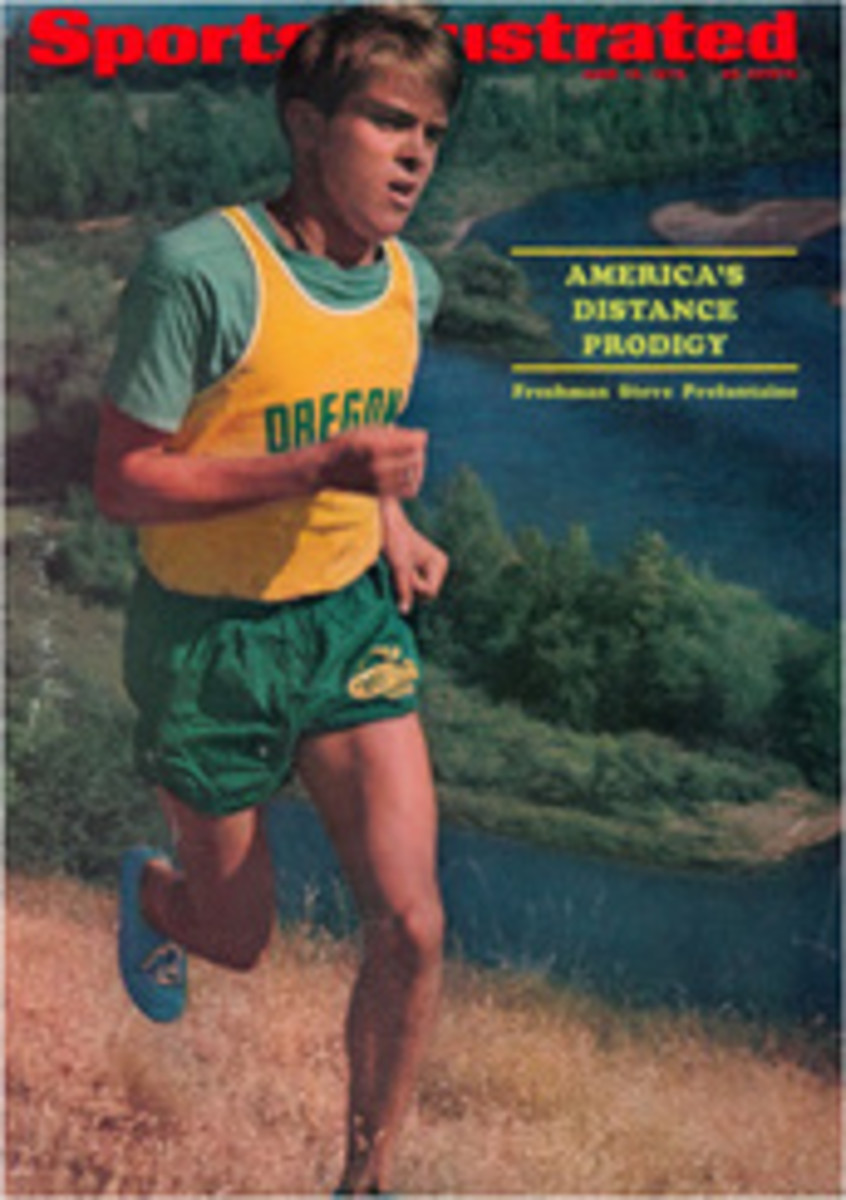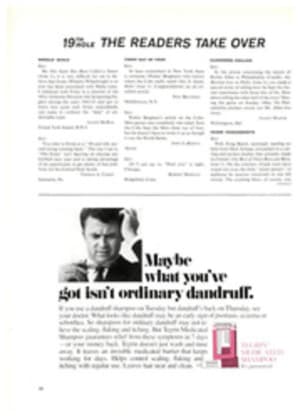
SCORECARD
CUPFUL
Packed into Madison Square Garden last Sunday afternoon was a huge, seething collection of summer street people—young Latins in white, short-sleeved shirts, long-haired European types in bell-bottoms, Spanish-speaking mothers with a baby in each arm. A fat man in iridescent blue, originally from Ecuador, stood up and roared, "Bra-sil!" A cop sharply blew his whistle and yelled, "Siddown." Yellow-shirted ushers rushed from row to row chasing fans from seats they didn't belong in. All were there to watch the closed-circuit satellite showing of the England-Brazil World Cup soccer game in Mexico. When Brazil's Jair Filho Ventura scored the only goal of the game, a group of frenzied West Indians tore off their shirts with joy.
Elsewhere, much the same scenes occurred. The general manager of the Maurice Richard Arena in Montreal was startled to find he had to turn away 1,000 people after filling to 5,200 capacity. In the San Francisco Cow Palace, a mainly Latin crowd of 10,000 let out a war whoop when Brazil scored, and in Detroit spectators leaving the Masonic Temple auditorium watched a tooting caravan of cars pull away with Brazilian flags flying.
To most Americans, soccer is an unimportant game. To the rest of the world it is the game, with the World Cup the grand climax. Indeed, by the time play ends in Mexico, an estimated one billion people will have watched it, including those delirious fans in the U.S. and Canada last Sunday.
BRAINCHILD
Southern California, the home of Hula-Hooping, skateboarding and other activities, has given birth to a new pastime—windsurfing. The sport is done with a 12-foot surfboard equipped with a universal joint, a double-hinged gizmo that allows a 14-foot mast to hold a 56-square-foot sail. The sail has a window in it so the surfer can see where he is heading at 20 mph. Windsurfing boards cost $300 and up. The sport is the brainchild of Hoyle Schweitzer of Pacific Palisades, a computer analyst, who simply wanted to be able to surf when the waves weren't up.
NO BLUES IS GOOD NEWS
As our Charles Goren anticipated, no member of the famous Blue Team will represent Italy at the world bridge championships in Stockholm later this month. No Blues even participated in the trials to select the Italian team, and all the players chosen are relatively unknown in international competition. This vastly enhances the chances for the Dallas Aces (SI, March 23) to win the title and bring the Bermuda Bowl back across the Atlantic for the first time in 16 years. Indeed, the Aces are now heavy favorites in the tournament.
I SPY
In Washington for a game against the Senators, Manager Charlie Metro of the Kansas City Royals saw something unsettling: a TV camera and cameraman in the deep center-field mezzanine boxes in Robert F. Kennedy Memorial Stadium. The camera was not there for the game telecast, and Metro did not believe it was there to help the Senators analyze their batting problems on film the next day. No siree, Metro charged the camera was there to steal the signs of the Kansas City catcher. "I've seen quite a few things in my time," he says, "and I make it a practice when I come to a ball park to look around and check things out. I had no idea Washington was using a camera. I just was looking around and saw it." Metro protested the game early, but his protest became moot after Kansas City won.
Metro, who says that other spy cameras are being used in the majors, has asked American League President Joe Cronin for a ruling. "They had one in Chicago when I was with the Cubs," Metro admits. "It was a closed-circuit camera, and its receiver was kept in a little room behind the Cub dugout that was always locked until the game started. The picture was so clear you could see the cuticle on the catcher's fingernails." Metro claims that he had the camera removed when he became head coach. "I didn't like the device," he says, "and besides, our batters were so poor they couldn't hit the ball even if they knew it was coming. Once when we were using the camera against the Cards, they beat us a doubleheader, 9-0 and 11-0."
THE WAY TO AMERICA'S CUP
Evidence accumulates that the French are serious indeed about their America's Cup challenge. Among other elements, the 40-man expeditionary force arriving in Newport this month will include a chef. One can see the crewmen now, their hearts soufflé-light as they begin each day's toil in the certain knowledge that evening will bring something on the order of a succulent sole bonne femme, not the dread American hamburger, bun soggy.
Not that the French have no worries. New York Financier Bruno Bich, son of the challenger, Baron Marcel Bich, says the U.S. is still substantially ahead in the important technical matter of cutting sailcloth, and the French can't believe that the U.S. helmsman they fear most. Bus Mosbacher, will not somehow contrive to steer the U.S. defender, although he has said he is not available.
If it turns out that Bus does return, and brings a hamper of sandwiches with him, the French will be in serious trouble, bonne femme or no.
HARSH WORDS FOR HABER
Handball's bad boy, Paul Haber, has finally run afoul of the sport's Grand Panjandrum, Bob Kendler, a millionaire Chicago home builder and president of the United States Handball Association. In the last five years Haber has boozed and caroused his way to victory in four national singles championships, most recently in March, and Kendler, a devout Christian Scientist, stood by him. Now Kendler has had it.
In the latest issue of Ace, the USHA magazine, Kendler has written an open letter to Attorney Ted Tannenbaum, Haber's partner in the new Professional Handball Association. "I think your idea has merit," writes Kendler, "but you picked the wrong man! Haber's influence has been sickening.... We don't think the symbol of our sport should be an athletic bum, even though his skill is outstanding." After more strong language, Kendler finally warns, "The USHA will not harbor any player who joins Haber's 'Play for Pay' gang."
SHEEPSKIN
Many a college football player who makes the pro ranks fails to get his degree. Such was the case with Roy Jefferson, who signed as a wide receiver with the Pittsburgh Steelers in 1965 after playing for the University of Utah. The fact that he lacked a diploma rankled Jefferson. "I kept looking back," he said. "I was ashamed and embarrassed that I did not have that piece of paper." After last season, Jefferson took a leave of absence from his personnel job at U.S. Steel and paid his own tuition at Utah. Last week he finally got his degree. "When I went to school as an athlete, a snowstorm could discourage me from going to class," he recalled. "Now I'd walk through two feet of it." Then Jefferson summed it up this way: "Football can get you there, but it takes education to keep you there."
DROPPED BATON
The Jackson Daily News Relays, for nine years Mississippi's largest and best track and field meet, died quietly this spring as the result of integration. The only people to notice its passing were dedicated track fans and coaches at schools who scheduled meets around the Relays.
The Relays, co-sponsored by Jackson Murrah High School and the Jackson Daily News, were first integrated in 1968. Black athletes participated in more significant numbers in 1969. However, pictures of black athletes who won Relay events were never published in either of Jackson's two newspapers.
With more school desegregation taking place this year, the decision to cancel the Relays seemed the only solution to the state's racists. In most areas sports offer a setting where blacks and whites can meet in honest competition. That, evidently, is not good enough for Mississippi.
WHEW
British Columbia, which is bigger than Oregon, Washington and California combined, is one of the world's most dynamic producers of foul smells. There are 22 wood pulp mills in the province, and from each emerges a smog of sulfide that affronts the nostrils with a stench reminiscent of rotten eggs, very rotten. Not that noses in British Columbia are the only ones affected. The odor of pulp mills is equally obnoxious to Swedes, Finns, Russians, Japanese, Americans or anyone else who lives near a pulp mill. But in British Columbia Ray Williston, the Minister of Resources, is making a desperate attempt to do something about it. He has offered an award of $250,000—to anyone, anywhere—who will develop a method or a device to eliminate pulp mill odor.
Pulp mill technologists believe they already have reduced the stench to a minimum. In pulp manufacturing wood chips are digested by chemicals, and the subsequent waste is then put through a complex cooking cycle. It is this which releases malodorous sulfide into the air. Repeated controlled burnings reduce the amount of waste to only one-millionth part of its original content. But a mere one part of this gas mixed with two billion parts of air sets nostrils aquiver with revulsion. The prevailing industry theory is that the gaseous residue responsible cannot be reduced any further, that nothing more can be done.
"People who talk like that are living in the world of yesterday," says Williston. "There has to be a solution." So far, the response to Williston's proposal has been remarkable. He has received more than 500 letters from all over the world requesting additional information, and engineers from Sweden, Japan and India have flown in to discuss the matter personally. The offer expires Jan. 1, 1973. Get busy.
McLAREN
Year after year, young New Zealander Bruce McLaren would come to America, shake the money tree that is the Can-Am Challenge Cup and return to his base in England with prizes in six figures. He built his cars himself—great brutish 200-mph sports cars—and they were incomparably better than those of his rivals. He drove them expertly, as did his fellow countryman and team driver, Denis Hulme. For three years McLaren and Hulme dominated the Can-Am series, the most important road-racing circuit in North America, so overwhelmingly that the crumbs remaining for others usually went to drivers in last year's McLarens. McLaren also built Grand Prix cars, in which he was a good, steady performer.
Of flash and glitter, McLaren had none. He had to make do with such quaint, old-fashioned virtues as character, courage, persistence, precise thought, careful organization. The nature of McLaren's calling, however, was such that fatal accidents could happen abruptly to the best and safest drivers. This, to our deep regret, was the case last week when a mechanical failure, beyond McLaren's immediate control, caused his newest Can-Am car to crash while he was testing it at Goodwood, England. He was 32.
INTEREST RATING
A Cincinnati building and loan bank is offering an official red, white and blue ABA basketball as a gift for every $250 deposit left 90 days. Think that's a bargain? For $1,000 left for 90 days, a depositor receives an ice bucket.
ILLUSTRATION
THEY SAID IT
•Jerry Levias, Houston Oiler flanker: "As the season progresses I get lighter, faster and more afraid."
•Mary Bacon, 20-year-old blonde jockey, on why she is always careful to put on her gold earrings before a race: "Just so they'll know I'm a girl."

